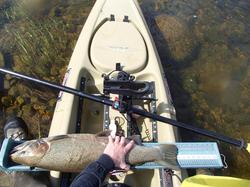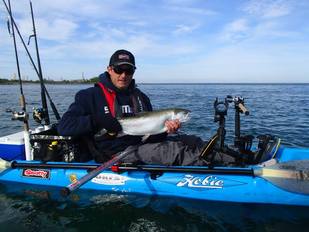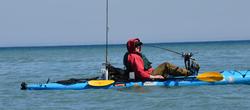|
Jeff Wall | Nomad Adventures [email protected] This article is intended to provide basic information to anyone wishing to take advantage of the spring Great Lakes Steelhead fishery. Although we are targeting migratory rainbow trout, there are many incidental catches that fill our day with joy and help us learn tactics for catching other species we may encounter. Rainbow Trout (Oncorhynchus mykiss) is a species of salmonid which is native to the cold water tributaries of Pacific Asia and North America. Steelhead is an anadromous(sea-run), or in this case, lake-run form of Coastal Rainbow Trout(Oncorhynchus mykiss Irideus) that have been introduced to Great Lakes tributaries. These fish spend their first 1-2 years in the tributaries, then enter the Great Lakes, to later migrate back to their natal streams when they reach spawning maturity. Primary spawning runs occur in the Great Lakes tributaries from late March to late May depending on the winter. Season and HabitatTiming as they say is everything. Especially on a sunny, warm spring day where the lake hasn't been stirred up much. If the water is clear and sun is high, then I'm already off the water looking at my pictures of the day's catch. A light wind is not a bad thing either provided it is in your favour. I prefer to fish a small chop when fishing steelhead and other minnow eaters. It displaces the baitfish more and allows for a wider, deeper zone to troll through. Fishing can be equally as good in the last two hours of daylight too. Finding a lightly wind blown warm shoreline near a creek or river can give whole new perspective on Great Lakes kayak fishing if you time it right! A spot where the sun has warmed all day long with a decent outflow nearby will start to get a trickle of minnows just before dusk that can provide fast and furious action as the sun disappears. Most of the time you are fishing less than 20' of water. Fish are shallow as 5' when the sun comes up and usually stay in less than 20' until then light starts to really penetrate then water. Try to find temperature gradients close to a mud line as they are your best indicator of where to start fishing. The transitioning water colour from brown to green is the area you want to focus on the most. This is where the bait are hanging out to avoid being in plain sight. Zig-zag trolling in and out of the mud line will surely get you bit. This is the season where kayaks have a real advantage over motorboats because of the relatively silent trolling capability. There is no need to run inline planer boards unless you do it to clear other rods when trolling multiple. If you have a leg propelled kayak like a Hobie Mirage series then things are even that much more simplified with hands free fishing. We primarily target spring Steelhead before they enter the tributaries to go about their reproductive business. Anytime that conditions allow and you feel you are capable of dealing with them is the right time to go. This article is not about safety so if you feel there may be a risk and are not comfortable with it, then do not go. Steelhead begin entering Great Lakes rivers in October and can still be around in early June. Spring runs are more consistent from April to mid May. Once they are safely higher up in the system, it is our practice to give them free passage. Although we are not afraid to go and pound on a fresh run of fish near the lower stretches of rivers, we prefer letting those who passed the gauntlet, to carry on and make lots of future angling opportunities. Especially on rivers that yield wild fish! Locating and Timing The old spawned out warrior in this picture is a catch we try to avoid but can't always when targeting migrating fish around rivers. For this reason we tend to concentrate our efforts in the lake near the river, rather than in it. He took about 5 mins to revive even in icy cold water. A chrome bright fish in the spring does not mean it is a fresh arrival! Many steelhead finish their spawning ritual before the river season opens, and they are almost fully healed from their wounds, leaving them with their beautiful silver sheen. These kelts are the most sensitive of the lot. They are extremely hungry and feed ravenously on anything they can find. They are also very susceptible to death if hooked and and fought to exhaustion with less oxygen in the warming rivers. They cannot recover since they have no reserve body mass to fall back on. Please do not target these fish!  This spring hen was caught in Lake Huron near a major tributary. She was fully recovered from spawning and caught June 1 gorging herself on shiners when she hit a Live Target Rainbow Smelt. Anything resembling a shiner or smelt style minnow and fished near a river outlet on the Great Lakes will get bit... by something. It will most likely be a steelhead, coho salmon, or brown trout but could be any number of other species following the bait. Move around in the lake until you mark bait or spot it. Baits and CombosThe two most important things even if you don't have a fish finder or pedal drive kayak, would be a couple good trolling combos, and some basic lures for spring chromers. Ideally you should have a light trolling combo like a 8-9' M/F rod with a baitcast reel, and a 8-9' Med/Mod trolling rod with a large capacity trolling reel, line-counter if possible. It is a good idea to have at least one 9'M/F spinning combo too for times when you have really keyed in on the fish, you can drop anchor and start chucking. Baits and lures are endless when you start looking at different possibilities. Try to keep it simple especially if you are just getting into it. Body baits like AC Shiners, Bomber Long A's, Live Target Smelts/Shads, Rapala Original Floater/Countdowns/J9/Shad Raps , Smithwick Rogues, and Storm Thundersticks. Use natural colours in clear water and bright Chartruese, Firetiger, and Orange/Gold in stained. All in 3-1/2-4-1/2" sizes. Remember the minnows are still small in the spring. Smaller light trolling spoons in 3-4" sizes like Michigan Stingers, Silver Streaks, Dreamweaver SS, and any other narrow profile spoons. Colours are fairly basic with orange trumping all, then greens, chartreuse, and blue/greens cover the majority. Flatfish, Kwikfish, and Hot Shots are all spring time staples for steelhead. The wide slow wobble of a Skunk, Blue or Green Pirate, and make sure to bring some golds too. A slow trolled Gold/Fire Orange in dirty water on an overcast day can be deadly! Lures like Cleo's, Krocodiles, Storm Wildeye, and the different body baits listed above all make for great casting baits for these fish. Technique Fish close to the mud line if there is one, and weave your lure in and out of the mud line but try to keep on the green side most of the time. The majority of fish will be caught in the pea green water that is located between the mud water and the deep green water. In the picture you can clearly see the water colour transition from light in the zone being fished to a deeper darker colour in the distance . Fish won't feed in the muddy water because it is difficult for them to see and to breathe in it but the bait will be hiding near there. Trolling speed is ideally between 1.5-2 mi/hr, making sure to form lots of "S" turns in hopes of enticing a follower to hit. Should you pinpoint a location where they seem to be congregating, be sure to anchor up and fire away. It may not last long but a half hour in the zone can easily produce several fish! SafetyI said I wouldn't mention it but it can never be overstated. If you are out on the water just after ice-out, then you are either a seasoned vet of the Great Lakes fishery or you are there with one. In all scenarios common sense applies, if you are worried about your abilities then do not go. Hypothermia doesn't discriminate. Spring steelhead kayak fishing on the Great Lakes is one of the most enjoyable fisheries we have available. These aggressive high flying fish will keep you going back for more every year!
Comments are closed.
|
FISHING NEWS ONTARIOOntario and Great Lakes region salmon, steelhead, and migratory trout fishing articles, information, news, and reports. Stay up to date on our most recent trips, events, tournaments, and general news on adventure fishing and kayak fishing in Ontario and Canada. Archives
April 2021
Categories
All
Links |



 RSS Feed
RSS Feed